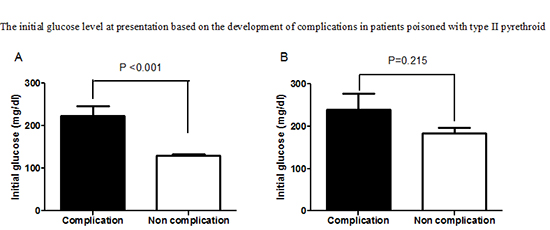1. Hideo K. Pyrethroid chemistry and metabolism. In : Krieger RI, editor. Hayes' handbook of pesticide toxicology. 3rd ed. London: Academic press;2010. p. 1635–1682.
2. Chandra A, Dixit MB, Banavaliker JN. Prallethrin poisoning: A diagnostic dilemma. J Anaesthesiol Clin Pharmacol. 2013; 29:121–122.
3. Ray DE. The contrasting actions of two pyrethroids (deltamethrin and cismethrin) in the rat. Neurobehav Toxicol Teratol. 1982; 4:801–804.
4. He F, Wang S, Liu L, Chen S, Zhang Z, Sun J. Clinical manifestations and diagnosis of acute pyrethroid poisoning. Arch Toxicol. 1989; 63:54–58.
5. Choi UT, Kang GH, Jang YS, Ahn HC, Seo JY, Sohn YD. Fatality from acute chlorfenapyr poisoning. Clin Toxicol (Phila). 2010; 48:458–459.
6. Mehrpour O, Alfred S, Shadnia S, Keyler DE, Soltaninejad K, Chalaki N, Sedaghat M. Hyperglycemia in acute aluminum phosphide poisoning as a potential prognostic factor. Hum Exp Toxicol. 2008; 27:591–595.
7. Luitse MJ, van Seeters T, Horsch AD, Kool HA, Velthuis BK, Kappelle LJ, Biessels GJ. Admission hyperglycaemia and cerebral perfusion deficits in acute ischaemic stroke. Cerebrovasc Dis. 2013; 35:163–167.
8. Smith RS, Fry WR, Philp FH, Philp AS, Berry SD, Helmer S. Mild hyperglycemia, but not glucagon-like peptide 1 predicts poor outcome after injury. Am J Surg. 2012; 204:915–919. discussion 9-20.
9. González Infantino CA, González CD, Sánchez R, Presner N. Hyperglycemia and hypoalbuminemia as prognostic mortality factors in patients with enteral feeding. Nutrition. 2013; 29:497–501.
10. Ishihara M. Acute hyperglycemia in patients with acute myocardial infarction. Circ J. 2012; 76:563–571.
11. Shavit I, Konopnicki M, Winkler K, Neuman G, Kozer E, Bentur Y. Serum glucose and electrolyte levels in alcohol-intoxicated adolescents on admission to the emergency department: an unmatched case-control study. Eur J Pediatr. 2012; 171:1397–1400.
12. Moon JM, Chun BJ, Lee BK. Glasgow coma scale score in the prognosis of acute carbamate insecticide intoxication. Clin Toxicol (Phila). 2012; 50:832–837.
13. Guo YJ, Zhou Y, Zhang SY, Wei Q, Huang Y, Xia WQ, Wang SH. Optimal target range for blood glucose in hyperglycaemic patients in a neurocritical care unit. Diab Vasc Dis Res. 2014; 11:352–358.
14. Planer D, Witzenbichler B, Guagliumi G, Peruga JZ, Brodie BR, Xu K, Fahy M, Mehran R, Stone GW. Impact of hyperglycemia in patients with ST-segment elevation myocardial infarction undergoing percutaneous coronary intervention: the HORIZONS-AMI trial. Int J Cardiol. 2013; 167:2572–2579.
15. Cha YS, Kim H, Cho NH, Jung WJ, Kim YW, Kim TH, Kim OH, Cha KC, Lee KH, Hwang SO, et al. Pyrethroid poisoning: features and predictors of atypical presentations. Emerg Med J. 2014; 31:899–903.
16. Yang PY, Lin JL, Hall AH, Tsao TC, Chern MS. Acute ingestion poisoning with insecticide formulations containing the pyrethroid permethrin, xylene, and surfactant: a review of 48 cases. J Toxicol Clin Toxicol. 2002; 40:107–113.
17. Magdalan J, Zawadzki M, Merwid-Lad A. Fatal intoxication with hydrocarbons in deltamethrin preparation. Hum Exp Toxicol. 2009; 28:791–793.
18. Cremer JE, Seville MP. Comparative effects of two pyrethroids, deltamethrin and cismethrin, on plasma catecholamines and on blood glucose and lactate. Toxicol Appl Pharmacol. 1982; 66:124–133.
19. Lock EA, Berry PN. Biochemical changes in the rat cerebellum following cypermethrin administration. Toxicol Appl Pharmacol. 1981; 59:508–514.
20. Bradbury JE, Forshaw PJ, Gray AJ, Ray DE. The action of mephenesin and other agents on the effects produced by two neurotoxic pyrethroids in the intact and spinal rat. Neuropharmacology. 1983; 22:907–914.







 PDF
PDF ePub
ePub Citation
Citation Print
Print





 XML Download
XML Download